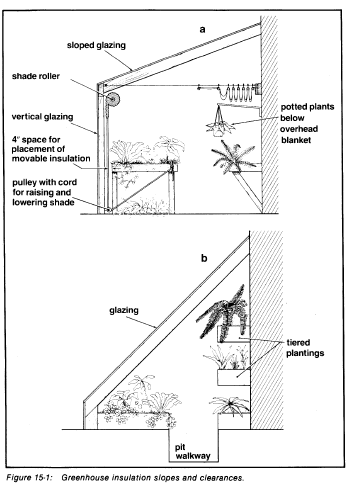Heating and Cooling Your Home
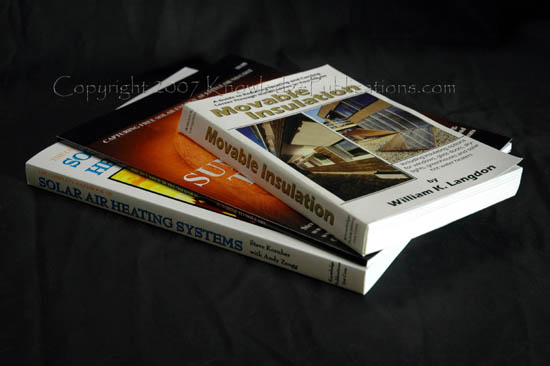
Movable Insulation $29.95
This is entirely devoted to insulating shades, shutters, panels and curtains. It is the most comprehensive and useful book on the subject of movable insulation that you will ever find, period. The book is pure genius; it details simple methods to STOP the HEAT LOSS from your house, including effective ways to use movable insulation systems to increase your home’s energy efficiency in both winter and summer, information and directions for owner-made systems, recommendations for where to get the best ready-to-but and custom-made units and instructions for determining the payback time and fuel savings that you can realize with movable insulation on your house.
With easy construction plans for easy insulated curtains, a HUGE variety of panels that you can put inside your windows, outside, and fold up/down and much more from an extraordinarily talented author, this 379 page book is an absolute must have for any homeowner that wants to STOP HEAT LOSS NOW!
Windows, Glass Doors, Skylights, Greenhouses and Solar Hot Water Heaters
If your home is a typical one, it loses 25 to 30% of its heat through its windows. If you have particularly large window areas, this heat loss may be 50% or more, even if they are made of insulating glass and face south! In this book you will find numerous movable insulation systems that will cut the heat loss through these windows in half!
Insulation has traditionally been a fixed item placed permanently inside walls, ceilings, and floors of a building to trap heat and create an effective thermal envelope. Insulation is most effective when this envelope is continuous and complete, with no gaps or weak spots. Windows penetrate this envelope and allow heat to escape. Movable insulation covers these gaps in the building's thermal envelope at night. Because this insulation is movable and not stationary, it can be removed during the daytime to allow light and solar heat to enter.
Many of the movable insulation systems in this book are first-generation items, created by people who are building and living in energy-responsive environments. Many can be home-fabricated and are fully diagrammed and described in Parts II through VI. Systems which are ready-made and available as off-the-shelf products are also included in each chapter. As you read this book, you will learn how much you can save by adding thermal protection to your windows.
The information here can also be useful in commercial and institutional buildings where abundant use of single glazing is causing a colossal loss of heat. This book could also aid those architects and engineers who are designing buildings which will respond to natural energy cycles. Window insulation speaks a new design language that is still foreign to many architects, and this guide helps to reveal some of the essential design details and criteria needed to apply such insulation. A method of assessing the economic return from a window insulation system in Appendix II and the listings of products, hardware, and components in Appendix III may be of particular interest to design professionals.
All practical solar designs begin with an energy-efficient design. Movable insulation reduces heating loads, thereby reducing the collector area required. In passive solar heating systems, movable insulation is often an integral component, helping heat-storage walls to retain their heat for longer periods of time. In cold climates, movable insulation enables the solar greenhouse to maintain growing temperatures without a supplemental source of heat. By employing movable insulation to enhance solar water heating systems, pumps, collector panels, and heat exchangers can sometimes be eliminated altogether!
Beyond the heat you save from these systems, there are additional benefits. Solar heat gain can be enhanced and controlled, privacy can be insured, and the spaces where these systems are employed take on new depths of relevance to their surrounding environs. The nuts and bolts of these systems, the dollars you can save, and their means of construction and operation are all fully examined in this fantastic book!
Table Of Contents
Part I Movable Insulation—Why Is It Needed Today?
Chapter 1 The Energy-Responsive Dwelling, Past to Present
A History of the Residential Window
Windows and the Energy-Responsive Dwelling
Window Areas and the Building Code
Chapter 2 Window Heat Losses and Gains
Window Air Infiltration Losses
Stopping Window Air Infiltration—New Products and Methods
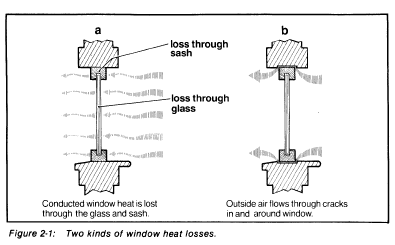
Window Air Infiltration Losses
Infiltration losses are difficult to measure precisely, yet they can be very significant. A single-glazed window that is loose and poorly fitted can lose twice as much heat through the air cracks (or through infiltration) than through the glass area itself (or through conduction) (see Figures 2-1 a and 2-1b). The amount of heat lost by air leakage depends not only on the size of the cracks around the sash and frame, but also on the outside wind speed and direction. Table AIV-1 in Appendix IV shows the number of cubic feet of air flow per linear foot of crack for several different types of sash treatments and wind speeds.
Conduction, Convection, and Radiation
R Values
U Values
Window Losses and Gains
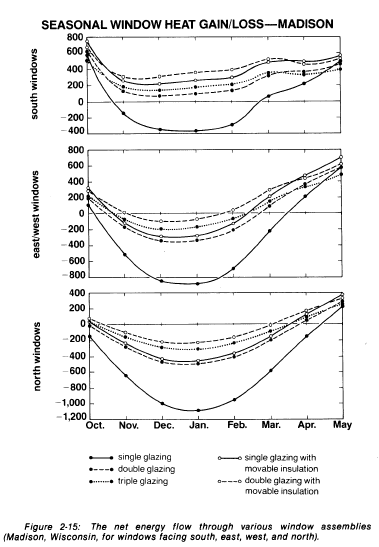
Figure 2-15 shows the net heat transfer through several types of windows facing south, east, west, and north throughout the heating season in Madison, Wisconsin. The line in the center is the break-even line. Points below this line indicate that the glass is losing more heat than it is gaining in a given month. Those portions of the curves above the line indicate net gains of energy.
South-facing windows are the most beneficial. A window assembly facing south is a net provider of heat, except for single glazing which is a net loser of heat, November through February.
East-facing or west-facing windows all lose heat in Madison during December and January, although with double glazing and R-5 night insulation, these losses are small. East and west windows are most beneficial during the springtime when the days are longer and much more sun can shine on them during early morning and late afternoon.
North-facing windows are invariably heat losers with single-glazed units dipping way below the others, as one would predict. However, before you entirely write off north-facing windows, note that this graph shows only heat transactions and does not include the energy benefits from natural lighting nor any aesthetic considerations.
The heat lost and gained through windows varies not only according to the window orientation and season, but is also determined to a great extent by the climate or location of the building. Madison, Wisconsin, was chosen here because it has very cold and sunny winters. Graphs for several other cities are shown in Figure 3-1.
Chapter 3 Enhanced Glazing Systems
Double Glazing
Triple Glazing
Moisture Between Glazings
Adding Layers of Glass to Existing Windows
Low-Iron and High-Iron Glass
Plastic Glazings
Chapter 4 Choosing a Window Insulation Design for Your Home
Orientation vs. Size
Operability
R Values
Cost
Edge Seals
Moisture Protection
Durability
Safety
Appearance
Plastic Foams and Fire Safety
Movable Insulation Inside Your Home
Part II Movable Insulation Inside Your Home
Chapter 5 Pop-In Shutters
Measuring a Window for Shutters
Materials for Pop-In Shutters
Glass-Hugging Pop-In Shutters
Edge-Sealed Shutters
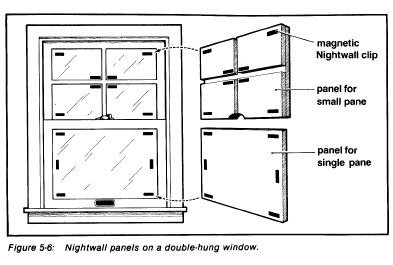
Many older homes have windows with numerous small panes of glass, usually in the upper sashes (see Figure 5-6). This multipaned design makes it difficult to place a panel close to the glass. A simple solution, however, is to cut a 3/4-inch beadboard section—thicker if necessary to fit into each section of glass. Fasten these pieces to the glass with adhesive magnetic clips and then take another sheet of beadboard cut to the size of the entire window sash and glue it to these panels. When the glue dries, remove the panel and you will have a single pop-in shutter with pieces that fit into each section of glass.
Friction-Fit Pop-In Shutters
A Shutter for the Muppets
A Heat-Collecting Pop-In Shutter
Daytime Storage for Pop-In Shutters
Seasonal Pop-In Panels
Chapter 6 Thermal Curtains—Blankets That Fold
Working with Existing Curtains
Bottom Seals
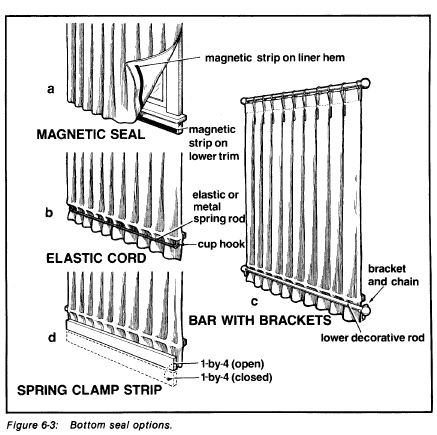 Bottom Seals - Because air, cooled by a window, tends to fall to the floor, the bottom seal on a curtain is the most important one. A versatile bottom seal for draperies is very difficult to design. No single method suits all window situations. A variety of bottom seal options are described below:
Bottom Seals - Because air, cooled by a window, tends to fall to the floor, the bottom seal on a curtain is the most important one. A versatile bottom seal for draperies is very difficult to design. No single method suits all window situations. A variety of bottom seal options are described below:
Permanent magnetic strip—This system provides an excellent seal that is easy to operate in most cases. A magnetic strip adheres to the window side of the liner hem and mates with a magnetic strip on the wall or on trim below the window. Care in installation is required so that the magnetic strips mate properly (see Figure 6-3a).
Elastic cords or metal spring rod (suggested by Clare Moorhead of Conservation Concepts, Ltd.)—Dress elastic or elastic cord can be used to make a bottom seal for narrow windows if the windowsill projects at least 1 inch from the wall. The elastic cord attaches to a cup hook (a 1-inch screw or nail can also be used), which is mounted just below the windowsill on each side of the window. The curtain is firmly sealed by pulling this cord out, tucking the bottom of the curtain under it, and letting it snap back in place (see Figure 6-3b). "Sash rods," which are long metal springs, can be used in the same manner as the elastic, although adjustments are sometimes required. They can be obtained in drapery hardware departments.
Bar with brackets (suggested by Bill Shurcliff)---Brackets can be installed on each side of the windowsill to receive a bar or rod. The brackets should be carefully located so that the bar presses the curtain snugly against the windowsill when it is lifted into these brackets. This bar can be a decorative curtain rod to match the curtain rods above. When the curtain is open this rod can hang from the brackets by a chain or rope (see Figure 6-3c).
Spring clamp strip—A 1-by-4 wooden strip can be mounted horizontally on the wall below the sill with spring-loaded (self-closing) hinges. The hinges for this wooden clamp strip should attach to the wall just below the bottom hem of the curtain. When the curtain is drawn, the wooden strip is opened to catch the curtain hem and then closed to clamp the curtain tightly to the wall with the spring action of the hinges (see Figure 6-3d).
Side Seals
Center Seals
Top Seals
Reflective Fabric Curtains
A Plastic Bubble Curtain Liner
Fiberfill Curtains
Fiberfill Shades
Edge Seals and Tracks
Roller Mechanisms
Dual-Shade and Triple-Shade Combinations

Insealshaid—This is a very clever shade unit with three separate shades for windows and glass patio doors. It is made by Arc-Tic-Seal Systems, Inc., P.O. Box 428, Butler, WI 53007. The unit comes complete with a reflective film shade on the window side, a clear film shade in the middle, and a black, heat-absorbing film shade on the room side. The four modes of seasonal day-night operation are shown in Figure 7-13. The shade housing has vents into the room that open automatically when bimetallic strips respond to temperatures behind the black shade that reach 82°F. or more.
Slatted Shades
Chapter 8 Thermal Shutters and Folding Screens
Side-Hinged Interior Window Shutters
Top-Hinged Interior Shutters
Interior Sliding Shutters

Panels that slide on hardwood rails can also be made for ordinary windows. Because they are smaller, and lighter, and are raised off the floor, the panels are farther away from dirt sources which can jam them. Figure 8-9'(modified for a window) shows how such a sliding shutter can be added to an existing window. Note how the edge seals are made to butt with a foam gasket. For wider windows the track can be extended to both sides of the window with a panel moving to each side. On a very large window a double track can be used so that the edges of the outer pair of shutters can interlock with the inner pair.
Pocket Shutters
Sliding-Folding Panels
Chapter 9 Insulation Between Glazing and Interior Louvers
Seasonal Insulation Between Glazing
Shades Between Glazing
Other Between-Glazing Systems
Louvers or Blinds
Part III Movable Insulation and Sunshades on Your Home's Exterior
Chapter 10 Exterior Hinged and Sliding Shutters

Figure 10-2 shows three types of exterior shutters with hinges either on the bottom, sides, or top. The bottom-hinged shutter opens to a horizontal position on a due-south window. It yields a significant increase in solar heat gained because it reflects" sunlight into the window at an angle that can penetrate the glass during the midday hours of most-intense sun.
Bottom-Hinged Shutters
Side-Hinged Shutters
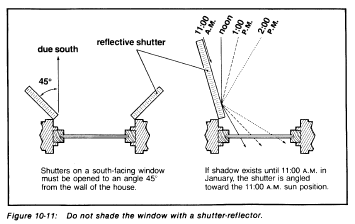
Side-hinged shutters can serve as reflectors to boost solar heat gains on winter days. However, they are only useful a couple of hours each day because of constant change in the orientation of the sun. The additional solar gain from reflective side-hinged shutters will be more than nullified if they shade a window during the main part of the day. These shutters must never block direct winter sunlight during the hours of 9:30 A.M. to 2:30 P.M. A clear opening, 45 degrees each side due south (see Figure 10-1 1), will insure against shading the window.
An exception to this rule can be made on homesites where another building, a mountain, or dense tree shades a southern wall between 9:30 A.M. and 2:30 P.M. On this type of site, the shutter-reflectors should be angled so that they take full advantage of the available hours of direct sunlight.
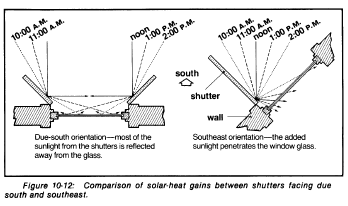
Side-hinged shutter-reflectors provide a larger increase in solar gains on windows that face southeast or southwest than windows facing due south. In Figure 10-12 a shutter-reflector is shown on a window facing due south and on one facing southeast. Most of the sunlight striking the shutter on the due-south window is either reflected away from the window or strikes the glass at an angle too wide to transmit light through the glass. The shutter on the southeast window significantly boosts the amount of light entering through the window throughout most of the day. Even on due-east or west windows, reflective shutters can boost the sunlight the window receives during part of the morning or afternoon.
Top-Hinged Exterior Shutters
Sliding Exterior Shutters
Chapter 11 Sun-Shading Screens
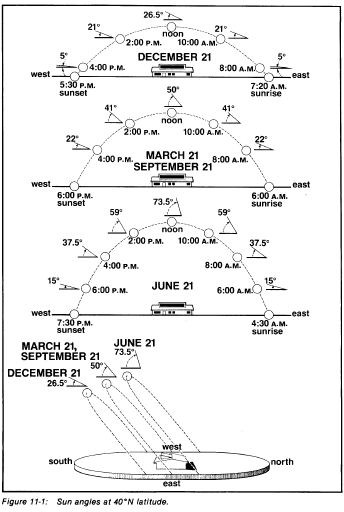
Before applying any type of outside shading, an examination of the hourly location of the sun during each season is necessary. Figure 11-1 shows the sun path for a middle (40-degree) latitude location (Philadelphia, Pennsylvania; Columbus, Ohio; Denver, Colorado) on December 21, March 21, September 21, and June 21. The sun rises at 7:30 A.M. on December 21, reaches an altitude of 21 degrees at 10:00 A.M., 26.5 degrees at noon, back to 21 degrees at 2:00 P.M., and sets at 5:30 P.M. On March 21 and also September 21 the sun rises at 6:00 A.M., reaches an altitude of 50 degrees at noon, and sets at 6:00 P.M. On June 21, the sun rises at 4:30 A.M., reaches an altitude of 37.5 degrees by 8:00 A.m., 59 degrees by 10:00 A.M., 73.5 degrees at noon, 59 degrees at 2:00 P.M., 37.5 degrees at 4:00 P.M., and sets at 7:30 P.M.
An Adjustable, Wooden Louvered Overhang
Shading Screens
Canvas Awnings
Chapter 12 Exterior Roll Shutters
Rolladen Shutters
Garage Door-Type Shutters
Part IV Movable Insulation for Skylights and Clerestories
Chapter 13 Shutters for Skylights
Sliding Skylight Shutters
Louvered Skylight Shutters
Hinged Skylight Shutters
Chapter 14 Shutters for Clerestory Windows
Top-Hinged Clerestory Shutters
Flip-Down Clerestory Shutters
A Sliding Clerestory Shutter
Protecting Other Types of High Vertical Windows
Chapter 15 Interior Greenhouse Insulation Systems
Insulating shades or blankets are often the most effective when they fill an entire wall or ceiling. Large, one-piece thermal barriers are ideal because they minimize the total perimeter of an insulating system and therefore minimize heat loss by air convection. If a long wall shade is used over glazing or in front of tiered plant beds, as shown in Figure 15-1, the beds must be set back not only from the glass, but also from the vertical posts or window mullions to provide clearance for the shade. Several other window insulation systems can be employed successfully but they must be tailored so they can be maneuvered into place without difficulty. Reaching over a 3-foot-wide plant bed is not too difficult, but reaching under one without disturbing the plants beneath it is very difficult. If shades are used, they should be rigged with pulleys and a cord so their daily operation does not require special gymnastics.
Pop-In Shutters
Roll Shades
Overhead Blankets
Hinged Shutters
Wing Bifold Shutter
Chapter 16 Exterior Insulation for Greenhouses
Blankets for Sun-Heated Pits, Cold Frames, and Small Greenhouses
Hinged Shutters
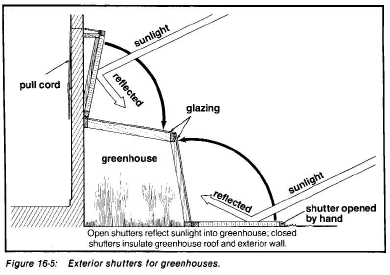
Figure 16-5 illustrates two other exterior, hinged shutters for greenhouses. The top of the greenhouse has a reflector-shutter that reflects low-angle winter sunlight onto plants. Shutters that swing up like this are exposed to heavy winds and require a sturdy frame behind them. A wooden frame can be braced against the second story of a house or posts can be extended through the top of the greenhouse and anchored to a wall or floor at the rear of the greenhouse.
The sloped, south wall of the greenhouse in Figure 16-5 has a bottom-hinged shutter. Unlike vertical-wall bottom-hinged shutters, which fall from their own weight, this particular shutter must be opened manually, a less-than-ideal solution.
Bifolding Shutters
Combinations of Systems
Part VI Movable Insulation to Assist Solar Heating Systems
Chapter 17 Movable Insulation to Assist Passive Space Heating
Night Insulation for Trombe Walls
Insulating the Exterior of Trombe Walls
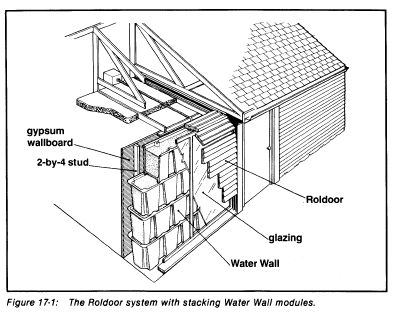
A cutaway view of a Water Wall Modular system, called the Roldoor, is illustrated in Figure 17-1. Standard gypsum wallboard is used inside the water wall to give a simple, clean, and traditional appearance to the interior, and also to slow down the rate of heat transfer into the living space. This gypsum board has about the same resistance to heat flow as the glass on the outside. However, the temperature difference between the water wall and outside is much greater than between the water wall and inside. With the insulating effect on the interior gypsum board included in this design, the night insulation provided by the Roldoor system becomes very important. Without the Roldoor system, most of the heat stored in the water wall would exit through the glass to the outside instead of gradually entering the interior.
Movable Insulation Between a Trombe Wall and the Glazing
Roof Ponds and Movable Insulation
Movable Insulation to Control the Rate of Heat Flow into a Home's Interior
Insulating a Freestanding or Discontinuous Mass Wall
Window Insulation Which Converts South-Facing Glass into a Hot-Air Collector
Chapter 18 Movable Insulation to Assist Solar Water Heaters
Bringing the Collector into the Home's Thermal Envelope
The Bread Box—Eliminating the Collector Altogether
The Capsule Collector
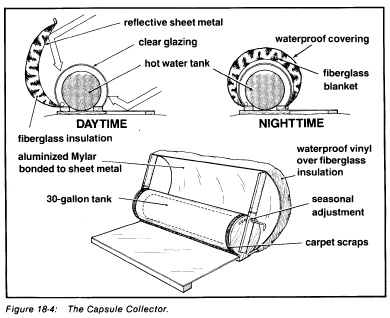
The fiberglass blanket in this design is attached to a curved sheet of galvanized steel that reflects sunlight onto the tank (see Figure 18-4). Aluminized Mylar is glued to this galvanized sheet to increase its reflective properties. Hinged 2-by-4s at each end of the tank hold the reflector in position and guide it as it closes. These arms are shifted seasonally to adjust the tilt of the reflector to winter and summer sun angles. A waterproof vinyl fabric covers the insulation on the outside. Carpet scraps are glued along each end and the bottom of the tank to make a tight seal when the cover is closed.
Appendix I Insulated Shade and Shutter Construction
Appendix II The Economics of Window Insulation
Appendix III Movable Insulation Products, Hardware, and Components
Appendix IV Further Technical Information
Appendix V Design Sources
Photo Credits
Index

Movable Insulation $29.95
This is entirely devoted to insulating shades, shutters, panels and curtains. It is the most comprehensive and useful book on the subject of movable insulation that you will ever find, period. The book is pure genius; it details simple methods to STOP the HEAT LOSS from your house, including effective ways to use movable insulation systems to increase your home’s energy efficiency in both winter and summer, information and directions for owner-made systems, recommendations for where to get the best ready-to-but and custom-made units and instructions for determining the payback time and fuel savings that you can realize with movable insulation on your house.
With easy construction plans for easy insulated curtains, a HUGE variety of panels that you can put inside your windows, outside, and fold up/down and much more from an extraordinarily talented author, this 379 page book is an absolute must have for any homeowner that wants to STOP HEAT LOSS NOW!




